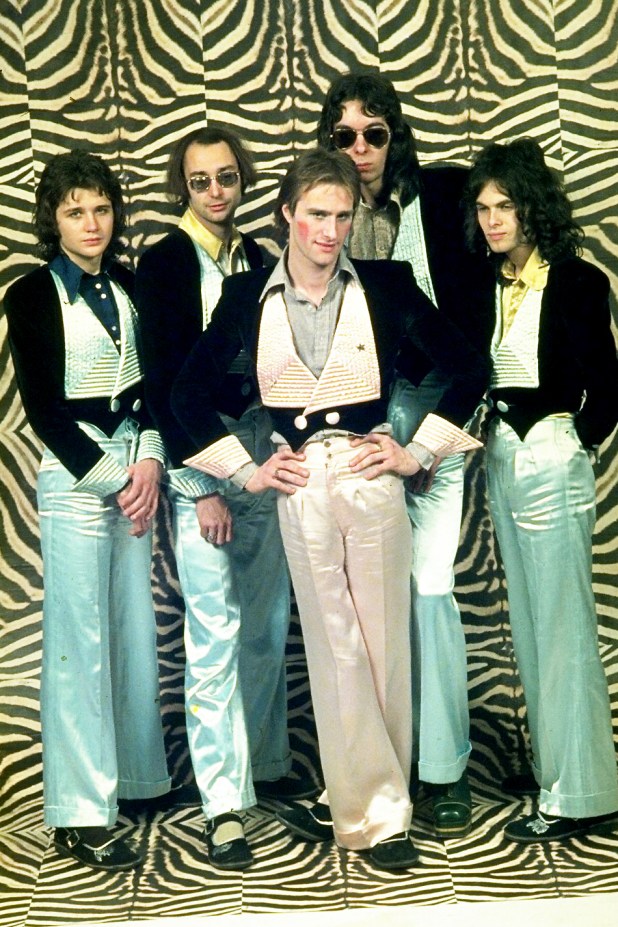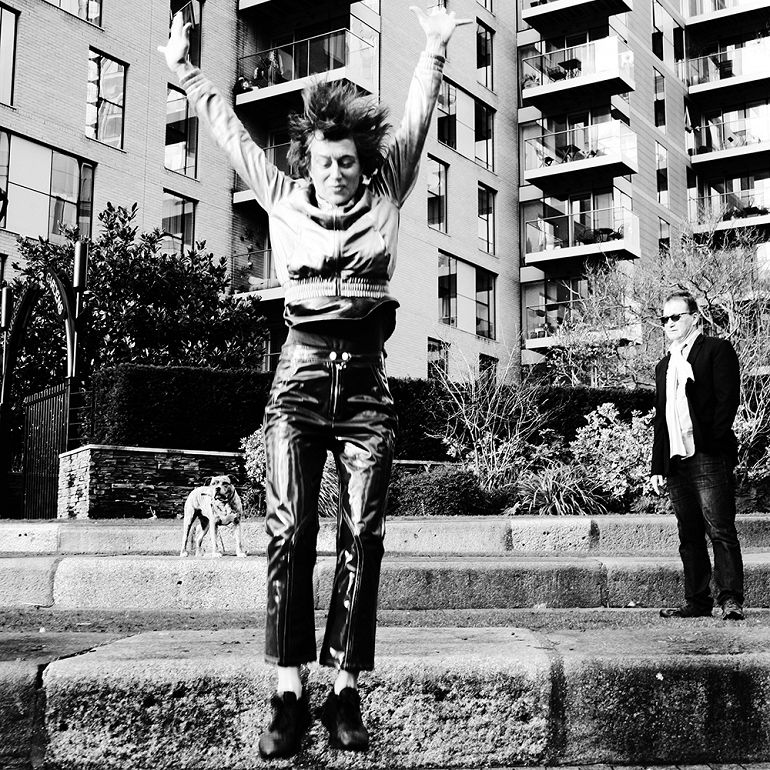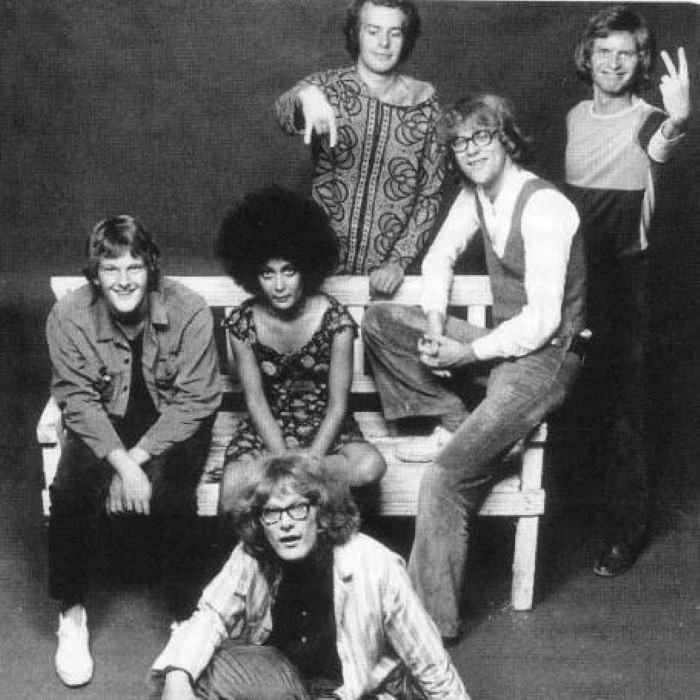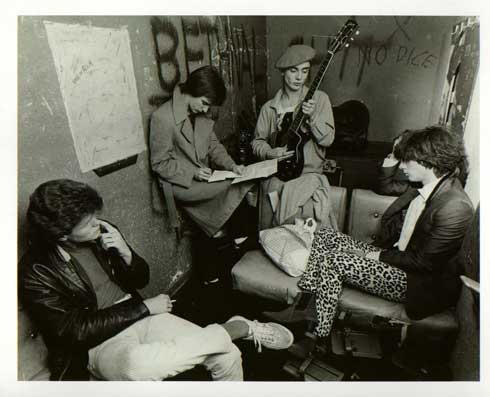
Hot trends: (1) Songs that turn into dub versions in the middle and get better when the do; (2) Latin rhythms from non-Latin people; (3) Instrumentals that might have been better with words attached.; (4) Songs by vocal groups where I only noticed one vocalist. Also, in a couple previous blindfold tests, the oldest song in the mix got the highest score. But pretty sure this is the first one that the oldest song came so close to getting the lowest score — placed second-to-last, if this was a tournament. Quite the milestone, even if the oldest one this time was nowhere near old as the oldest ones those other two times.

Harpo “Motorcyle Mama“ (single and on Moviestar, both 1975, later included on Harpo Hits!, 1977 and Portrait of Harpo, 1991; Swedish pop singer who hit the charts in several continental European markets in the mid ’70s): Auto ignition revs up sweet post-exotica ’60s pop arrangement, though once the words start it’s pretty clear the ignition’s from a motorcycle and the pop is from the ’70s, looking back “before Woodstock” to 1965 “when Jimi Hendrix was still alive,” and then to “flower power heaven” 1967. Fey singer remembers Fritz the cat and leopard skin pillbox hats and Sgt. Pepper’s band and his long-gone hippie girlfriend. Glam-rock nostalgia, probably from England. 6.5
Shockabilly “Tennessee Flat Top Box“ (from Earth Vs. Shockabilly, 1983; “avant-rock band from New York City,” featuring “Eugene Chadbourne on guitar and vocals, Mark Kramer on bass guitar and organ, and David Licht on drums” [Wikipedia]): Border rhythm distorto-noise rock (after a mellow start) that I first took for a Marty Robbins cover but before long revealed itself to be Eugene Chadbourne circa Shockabilly covering “Tennessee Flat Top Box,” which song I personally know from Rosanne Cash’s King’s Record Shop which I reviewed for Creem at the time (her last album before she fell asleep, where to be honest it always struck me as kinda corny and cutesy), though I’m pretty sure her dad did it first. Chadbourne’s guitaring (or raking) is a marvel as always, and as always his singing is a joke on purpose, not an awful thing since the avant-garde usually could use a bit more fun. By the end, he gets kinda sleepy himself. 6.5
Annette Peacock “Pony“ (from I’m the One, 1972; “composer, musician, songwriter, producer, and arranger” from Brooklyn, “a pioneer in electronic music who combined her voice with one of the first Moog synthesizers in the late 1960s” [Wikipedia]): Bluesish psychedelic rock, but noisier than that, and with a sort of wah-wah funk to it, then space-age astronaut sounds. The singer sounds kinda opiumed out, but attempts Janis Joplin wails and maybe guitar wails anyway — Mother Earth? (Is that the band whose vocalist Greil Marcus said got to places even Janis couldn’t reach, or am I confusing them with somebody?) Joy of Cooking? Annette Peacock? Verges on self-parody, no matter who, especially if it’s dredging up unexplored depths of emotion. But the rhythm, which is basically just a funk vamp, keeps going on and on. And the coda takes quite a while to peter out. 6

La Bionda “There For Me“ (from La Bionda, 1978; “duo from Milan formed by brothers Carmelo and Michelangelo La Bionda, who are considered the inventors of Italian disco music” [discogs]): EZ-listen ballad schlock with Manilow piano under Bowie crooning, not a Bowie mode I’ve ever been particularly fond of. Yacht-rockish horns enter and return, the warmest element in the song, and later there’s some female vocal backup. Melody vaguely recalls “Too Late” by Carole King. 3.5
Dave & Ansel Collins “Do Your Thing“ (1974 single, included on Double Barrel: The Best Of, 2002; Jamaican reggae duo): Raw ska (or rawk steady?), but questionably Jamaican thanks to a clear James Brown (or Stax?) influence, e.g. in the funk vamp (see song before last) and “good gawd!”s and “hungh!”s and yelps of that sort and “c’mon baby, work it on me” asides. The guitar is definitely reggae though. 6
Fresh Face “Huevo Dancing“ (1982 single, only record by dance-pop trio recording for South Carolina label Catawba Records; featured on compilations such as Dureco Benelux’s 1983 High Fashion Dance-Music – Volume 2): A man and woman discuss the important subject of Smurfs over the phone, and somebody introduces “this new dance called the huevo” which apparently involves jumping to the beat and shuffling left and right — steps simple enough to be done in a line at a wedding reception. Did I dream this, or was “huevo” what “Latin freestyle” was originally called? Said beat is partially attributable to a hard, fuzzy bassline, accentuated by “hwoooah hwoooah” disco calls (that’s what the Beastie Boys called them but what did Donna Summer call them?) and an aerosol Febreze can spritzing air freshener across the dancefloor. Somebody calls back on the phone in what I take to be a Nuyorican accent as hollow congas start fleshing out an increasingly dub-spaced sound that suggests something either produced by Arthur Russell (in his Dinosaur L guise) or on Ze Records. A party starts up in the background and fun little rhythm doodads pop off at unusual angles and false starts keep teasing you it’s time to sit down but nope it’s not! Incredibly, it actually gets more compelling as it goes on. 7.5

Cockney Rebel “Judy Teen“ (1974 single, included on several later archival sets under the name Steve Harley, Cockney Rebel or both; glam rock band from London whose “music covered a range of styles from pop to progressive rock” [Wikipedia]: Latin syncopation at the start had me guessing August Darnell until Bryan Ferry-style mannerisms about scene-queen teen Judy reminded me it’s Steve Harley and Cockney Rebel instead (not to be confused with Alex Harvey or Cockney Rejects even if ugly American me used to). Dinky faux-flamenco percussion and Harley’s “r”-rolling and churchbell vocal backup help create their own little world about a hot (or not) child in the city, glam rock’s greatest subject. Feels like a hit single, a ’70s British one at least, which I have to assume it probably was. 7.5
National Health “The Bryden 2 Step (for Amphibians) (Part 2)“ (from Of Queues and Cures, 1978; “English progressive rock band associated with the Canterbury scene” [Wikipedia]: After a brief hint that it might be synth-pop, this quickly establishes itself as prog: An extended exotic multi-changeo opening with woodwinds or whatnot, guitar like Robert Fripp in King Crimson. Oddball beauty, with a bit of suspense-film theme sneaking around the alley. Still, I hoped for a song and got a composition. One without singing; lost track of how many parts it has. Does not get more compelling as it goes on. 5.5
Populäre Mechanik “Schlag Die Weissen Mit Dem Roten Keil No.1“ (from No. 2 cassette, 1982, compiled on Kollektion 03, 2015; “experimental rock, jazz and electronic group from Berlin” [discogs]): Xylophonic or maybe marimbaphonic plinks and plonks — might even be silverware clanked around on a cafeteria tray, which continues for a minute and which’d be pretty funny if this turned out to be say “Supper’s Ready” by Genesis. I forget how that sounds, but the melody here curiously reminds me of Peter and the Wolf. (Prokofiev, right?) Underneath there’s a funk guitar, not prominent enough to keep the keyboard from dragging us down toward schmaltztown. 5.5

Maximum Joy “Mouse An’ Me“ (from Station M.X.J.Y., 1982; co-ed Bristol, UK post-punk band): Light funky rhythm and a high vaporous woman’s voice, wafty and lacking gravity, chanting mantras about sensation, creation, inspiration, generation, mezmerization, intuition, simulation, exultation. Cool rhythm shuffles and military drum patterns are already suggesting another Arthur Russell production by halftime, when the bottom — no, pardon me, the top — drops out. And just like the huevo dance selection up above, this one gets better once it’s turned into a dub experiment with nobody singing anymore. 6.5
The Unclaimed “The Sorrow“ (from The Unclaimed EP, 1980; L.A. garage rock band): “The trees were raining and the skies were glowing, is the physical reality really worth knowing?” — ’80s garage punks approximating the moment when ’60s garage punks discovered LSD. They want really bad to write like Roky Erickson or Arthur Lee or at least the first Angry Samoans EP. Singer says he knows our mind ’cause he’s seen inside. He’s got a decent voice but comes off a bit staid; American no doubt, but could afford to sound snottier. 6
Frank Soda and the Imps “No Talk All Action City“ (from Frank Soda and the Imps, 1980, included on High Times: Greatest Hits 1979-1995, 2006; Toronto hard rock band fronted by Italy-born, British Columbia-raised guitarist “known for his warped sense of humor; he appeared on stage in strange outfits and the climax of each show involved making a TV explode on his head” [discogs]): More fast and bumpy hard rock, but with rockabilly hiccups like Robin Zander would do them emerging out of hoarse vocals about street violence. Makes for more convincing and propulsive would-be ’60s punk than the previous number, but I bet they consider themselves “metal” — ultimate evidence being Ratt-like squeals the singer ends on. 6.5
Kano “Now Baby Now“ (single and on Kano, 1980, collected on Greatest Hits, 1996; Milan “Italo-disco/electro project” [discogs]): Handclaps out of “Car Wash” by Rose Royce then an electrocutied rubberband bassline and big thumping synthbeats, yet extremely pretty despite the interchangeably disembodied robotic vocals — Italodisco, and easily the most purely fun and functional and least self-conscious song in this mix so far. The words aren’t even all that decipherable — “let’s go walking, walking” or “rocking, rocking,” who knows, who cares? You get the idea they don’t understand English very well anyway. Another extended cut (12″ not just 7″ length) that earns its extensions. And finishes like it began, with handclaps. 8
Claustrofobia “Mamma Winnie“ (single and on Repulsión, 1987; Spanish “art-rock/darkwave/post-punk” band, “pioneer in ‘mestizos’ sounds” [discogs]): More Latin rhythm, distantly descended from either “La Bamba” or whatever “La Bamba” itself was descended from. Unless the rhythm is African instead. “Mamamama Ma Ma Ma Ma Weenie,” a male singer stretches and improvises as women join in on harmonies. Then the rhythm’s back to a…rhumba? Something Caribbean? Or from the French Antilles, maybe? I hope this was a giant hit all across the global south. When the singer very clearly commands “Mambo!,” rattling percussion answers in kind, then more congas or timbales. Then somebody says something in what strikes my untrained ear as French, which may or may not support the Antilles theory. 7.5
Dunkelziffer “Keine Python“ (from Colours and Soul, 1983, included on 2021 Bureau B Germany compilation Eins und Zwei und Drei und Vier: Deutsche Experimentelle Pop-Musik 1980-86; “part of a family of Krautrock related acts from Cologne” [discogs]): An obese thump of a beat cuts the ribbon on a dub superhighway from outer space back to the inner earth, vocals that seem to be female weaving in and out of cavernous drum traffic like they’re knitting a sweater, sometimes in reverse. Can you knit in reverse? Could New Age Steppers? 6

Savage Rose “Dear Little Mother“ (on both Refugee, 1971 and Dødens Triumf, 1972; Danish art rock band): A dark but shiny late ’60s organ sound. Zombies-esque maybe, what aficionados of the era call “baroque pop” I believe. A woman (whose gender took me by surprise) asks Little Mother what’s in her bag, notes the note from Mr. Postman’s beloved, praises the fine dress Mr. Jailer’s wearing, and questions Mr. Hamster (well, that’s what it sounds like) about death. She goes through the list three times, in fact. I’m not entirely clear why. 6.5
Maximum Joy “Silent Street/Silent Dub“ (B-side of 12-inch “Stretch” single, 1981, included on 2017’s I Can’t Stand It Here On Quiet Nights: Singles 1981-82 and 2011 Strut UK compilation Disco Not Disco: Post Punk, Electro & Leftfield Disco Classics 1974-1986; co-ed Bristol, UK post-punk band) Slow and spare drum patterns under female vocals floating upward toward the sky like a bird, asking for music all day long and rejoicing in “the emotion (or motion?) of the heartbeat” between randomly timed spurts of bass (and, later, piano.) As soon as she starts singing I’m convinced this is something off the Raincoats’ third album Moving, the one where they made their “world-beat” move and frightened punk purists who thought they were turning into folkie feminazis (despite having never not been feminists since they covered “Lola” without changing its genders, but never mind.) Though I dunno, come to think of it this might be too subdued for even later-period Raincoats. Still, I like the extra little touches, the noir-jazz saxophone parts for instance, which get gradually less subdued as the song progresses. So yep, here’s yet another track that improves its grade unexpectedly in final minutes of the semester as it morphs into its own dub version, a shadow or doppelgänger (yes, I did indeed just finish Naomi Klein’s book) of its original self. 7
Hotlegs “Fly Away“ (on Thinks School Stinks, 1971, British pop-rock band that hit big across Europe and North America with “Neanderthal Man” then evolved into 10cc): Just a lady (I think) and her piano and an occasional string instrument, alone in the middle of a field, and she seems rather genteel and school-marmish, truthfully offering “no surprises up my sleeve,” telling tales of a (witchy?) woman riding “the wind where she belongs, though she longs to fly, to fly away.” A brief promising mention of a “union line” makes me think this might be an old folk song, but I’m not sure how the union fits into the rest of it. 4.5
Billy Joe Royal “Campfire Girls“ (1966 single later included on several best-of anthologies; Georgia-born country soul singer): Bo Diddley beat promptly upstaged by a man telling a woman that she needs to go join the Campfire Girls and take piano lessons and get a doll like all little girls supposedly do, as if all little girls do the same stuff in the first place — in other words, he wants her to return to square one, not pass Go or collect $200. Mansplains that she needs to learn about the birds and bees, so maybe he’s just sore because he couldn’t get past first base. The resentment might have worked if he was a garage-punk grease-monkey, but as is he just sounds smug, smarmy and sexist — an incel before his time. Does make me wonder whatever happened to Campfire Girls though — and what was their Brownie equivalent, the Bluebirds? Or was that an entirely different cult? 4
Decibel “Fakma“ (on El Poeta Del Ruido, 1980; Groundbreaking Mexican RIO [Rock In Opposition] type, cross-culture, rock, folk and jazz hybrid band” [discogs]): Outer-space keyboard effects and transmissions from another galaxy by a mad scientist — would make an okay planetarium soundtrack. Not much rhythm or melody to speak of, but I dig those accidental dub echoes á la the Chambers Brothers in “Time Has Come Today.” Except they had a song to go with it. 5.5
Pointer Sisters “Don’t Let a Thief Steal Into Your Heart“ (from Priority, 1979): Soul-blues vocals from either a woman or a falsetto-prone man, atop danceable Motown funk slowly building toward rock territory. Probably a woman, since the words are one of those who’s making love to your old lady while you were out makin’ love style lessons about how the scheming cheater gets schemingly cheated on. Okay, that logic doesn’t make sense, since “Who’s Making Love” was sung by Johnnie Taylor, but I think this is a woman anyway. Midway through, the lyric takes a sort of left turn — “How many times did you meet somebody, when they said they had real peace of mind,” then something about how “you’re living in Greenland, and you’re walking in quicksand”! Who lives in Greenland?? Maybe they meant Iceland. 6.5
Slip “Hot Jungle“ (single B-side, 1984, and on The Slip EP, 1985; (“electronic-popmusic project, produced by Manfred-Alois Segith from Munich…who is better known by his stage-name Fancy” [discogs]): More Caribbean rhythm…as disco, apparently. Electric salsa, more or less in the sense of “Cuba” by the Gibson Brothers. A loud, low instrument (possibly designated “guitar”) intrudes with intermittent shocks of crunch. Actually, I expect that this is a continental European (perhaps Mediterranean) interpretation of Caribbean rhythm — probably counts as “Italodisco,” though I’m guessing not technically Italian (apparently not a requirement.) With a sweet, flimsy woman’s voice saying what sounds like “aaaaaaa…..Jamon!” now and then. 7.5

Rich Kids “Strange One“ (from Ghosts Of Princes In Towers, 1978 and on The Best of the Rich Kids, 2003; London new wave band featuring Glen Matlock after leaving the Sex Pistols and Midge Ure after he left Silk but before be formed Ultravox): Sleazy snarl muffled by murk and rock guitars, but at least three times I make out: “Such a sensation, burning me up inside, just what it is, I! can’t! find!” Parts remind me of “Agitated” by Electric Eels, though not nearly as tense. Title is clearly “straaaaange wunnnnnnn.” Probably Brit, maybe goth. 6
The Vogues “Turn Around, Look at Me“ (single and on LP of the same name, 1968, then The Vogues’ Greatest Hits, 1969; male vocal quartet from Pittsburgh suburbs): Sunny ’60s middle-of-the-road croon pop by polite contemporaries of the Four Seasons and Lou Christie, probably, or maybe somebody a little later. Something of a creepy stalker song: “There is someone way behind you, turn around look at me.” He seems to be saying that he’s walking in her footsteps. Schlock, but not low-quality schlock. Semi-Sinatra-esque ending.6
Dennis Alcapone “Table Gonna Turn“ (on Investigator Rock, 1979 and Yeah Yeah Yeah Mash Up The Dance, 2012; “Jamaican reggae DJ and producer”[Wikipedia]): Deep reggae bass, then U-Roy or one of his many disciples dodges incidental dub interjections to toast and sing and emit high-pitched squeals and asides: “Waaaaugh!!” Just-issss!” “Fi-ya! Fi-ya!!” He’s quite versatile, dealing joyous apocalyptic commentary about flipping over tables in Babylon, like Jesus dealing with the temple’s money-changers. Literally turning the tables. But first, he really wants to do it all night with you. Amazed he has time! 7

For what it’s worth, the Pointer Sisters number is a Richard Thompson cover. It appears on Richard and Linda’s 1979 release, “Sunnyvista”. Maybe that explains the reference to Greenland.
LikeLiked by 1 person
Ha, I actually have a copy of Sunnyvista on my LP shelf, and didn’t even recognize it! Now, if they had covered “Saturday Rolling Around” or the title track instead… (Actually, I just pulled out my copy, and “Don’t Let a Thief Steal Into Your Heart” is not on there! Carthage US 1979 pressing — maybe that has something to do with it. Unless it has an alternate title I’m not aware of.)
LikeLike
My bad, it is actually on 1978’s “First Light”.
LikeLike
Oh okay. Fairly certain I’ve never heard that one.
LikeLike
via facebook:
Graham Ashmore
“Judy Teen” hit #5 in the UK charts (in my memory it was #4, for some reason). First Cockney Rebel I ever heard.
James Auburn Tootle
“Meh” on the Kano song; I can’t go “whoomp, there it is” over it like I can with “I’m Ready”.
There are sporadic melodies and rhythms on that Decibel record – this one starts in a black-and-white French cafe, then turns into a spy flick.
Chuck Eddy
Kano album has some 8.5s and 9’s on it — Heck, “It’s a War” might be a 10!
Anthe Rhodes-Liuzzo
That’s quite a wide swath, Chuck! And those pants!
Steve Pick
I don’t think there’s a single song I recognized here, but your descriptions have me intrigued by Fresh Face, Kano, Maximum Joy, and Claustrofobia. Considering I’ve loved “Double Barrel” by Dave & Ansel Collins since it broke into the Top 40 back in 1971 and I heard my first reggae record years before I knew reggae existed, I’m surprised I haven’t ever heard anything else by them.
Chuck Eddy
Me too! “Double Barrel” on 45 was always a staple of my vinyl bar DJ sets back in New York. Figured it was about time to investigate them further.
Clifford Ocheltree
Had the pleasure of seeing / getting to know the folks in Savage Rose during the ’80s and early ’90s. Almost always at small clubs on Fyn. With some exceptions the shows tended to be much stronger than the LPs from the period.
Mark Kemp
That Chadbourne pic took me straight back to my teen years spent at Aliza’s Cafe on Tate Street in Greensboro. NC.
William Boyd
I attended UNC-Greensboro in the 1982-1983 school year! My family was living in Winston-Salem at the time. Was Aliza’s Cafe that little place across from the Science building? If so, that’s where I saw the Violent Femmes play a gig! I also saw Neil Young at the UNC-Chapel Hill basketball arena that school year.
Chuck Eddy
I’m confused — are y’all saying Charbourne was a regular at that particular Greensboro venue? (I honestly don’t know much about his history — Wiki says he was “born in Mount Vernon, New York, but grew up in Boulder, Colorado.”) Or Mark, are you just saying that cafe had an excellent landscaping crew particularly efficient at raking leaves??
William Boyd
I met Eugene Chadbourne when I was going to UNC-Greensboro. It was at a gig in that area. Frankly, he was very standoffish and jittery in person, but the gig was amusing since he brought his rake.
Mark Kemp
Yes, Aliza’s (later the Nightshade) was a little underground speakeasy sort of thing near the campus of UNCG in Greensboro. Eugene was based, for the most part, in Greensboro from the late ’70s until, I don’t know… maybe he still lives here — I haven’t heard talk of him in decades, though. He played solo (with his rake), with Shockabilly, and with various other avant-garde configurations for years, and my friends and I loved to go see him. He was just so wild. It was pretty much my first exposure to total avant-garde and free jazz. Aliza’s had a lot of weird free jazz and whatnot. Another outfit that I liked, called the F-art Ensemble, played there, too. (And they lived up to their name! Haha.) Aliza’s was across the street from a little pizza joint called Friday’s, which is where all the early punk bands played when they came through. R.E.M. famously played there, as did Black Flag, Bad Brains, Violent Femmes, etc. William Boyd, where you saw the Violent Femmes was probably Friday’s. If it was their 1982 show, I was there, too.
William Boyd
I was thinking about Friday’s apparently, that must have been where I saw the Femmes? it was a small place with a lunch counter and the Femmes played in the front by a window. I know it was on the East side of Tate, across from the campus.
Mark Kemp
Yep, that’s it. The stage was tiny, and it was on the same level as the floor. I saw so many great shows there.
William Boyd
Yeah. Gordon Gano was wearing a bathrobe. It was a fun show. In 1983 I saw R.E.M touring behind Murmur at Beaty’s, an outdoor venue in Winston-Salem. I really liked North Carolina. What’s in that space now? Thanks for telling me it was Friday’s—I had forgotten the name of the venue.
Mark Kemp
It’s a tattoo parlor now.
William Boyd
I loved that little place. There was also a cool little bar on the North side of Walker that had a great old jukebox. Do you recall the name of that place?
Mark Kemp
Are you thinking of New York Pizza?
Willam Boyd
No this was just a small bar. Maybe it was on Spring Garden ? I also loved the movie theatres that had a full bar. I had never seen that before
Daniel Durchholz
Once, when Eugene Chadbourne played Cicero’s Basement Bar in STL, he held out his electric rake to me and I got to “play” it for a few seconds. Shoot, now I’m going to have “Fried Chicken for Richard Speck” stuck in my head all day.
Edd Hurt
Annette Peacock is no Terry Garthwaite or Tracy Nelson–pseudo blues singer, kind of annoying.
LikeLike